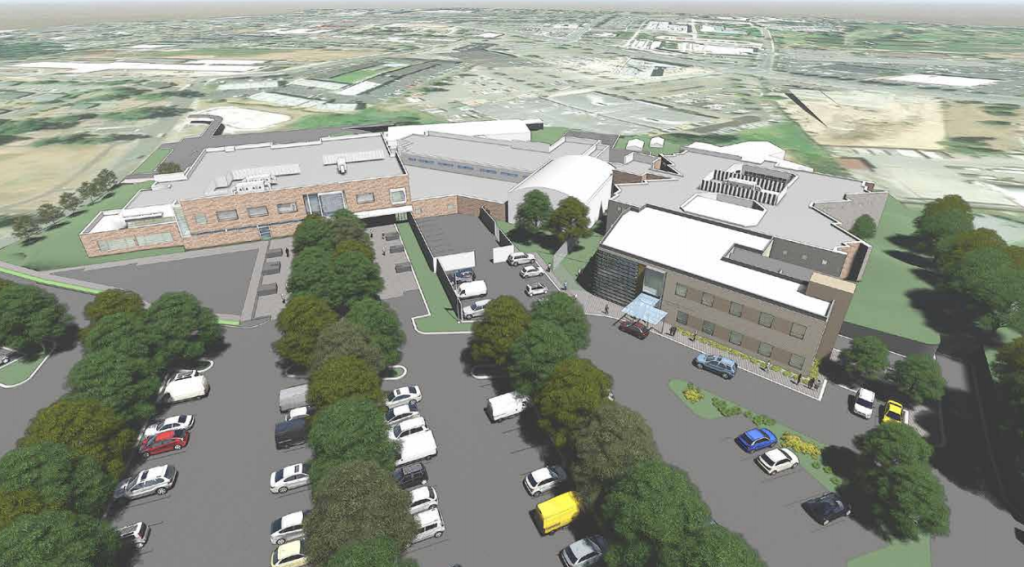EVERETT, Wash., July 14, 2021 – Today, Snohomish County, along with its partners, announced the completion of the North Sound Behavioral Health facility at the Denney Juvenile Justice Center in Everett.
The facility will help the county address the local, regional and statewide challenges related to the opioid epidemic. The facility will have two units totaling 32 beds designed to serve adults struggling with behavioral health issues. One unit (16 beds) will focus on adults with a primary addiction to opioids. The other unit (16 beds) is designed to treat adults with addiction issues and mental health needs. The facility is run by Pioneer Human Services, a state licensed, well respected and experienced social service provider.
Most treatment services will be funded through the federal Medicaid system. Previously individuals eligible for Medicaid funded treatment were forced to leave Snohomish County for care, often going to Eastern Washington for treatment, making it difficult for family engagement and education.
The renovation of the facility was funded by: an appropriation from the Washington State Legislature to the Washington State Department of Commerce ($11.37 million); North Sound Behavioral Health Organization ($3.34 million); and Snohomish County ($2.8 million) for a total budget of $17.51 million. The Denney Center will began accepting patients later this month.

“Our community needs the
capacity to take care of those who are suffering from addiction and behavioral
health issues,” said Snohomish County Executive Dave Somers. “The new inpatient
treatment facility fills a huge need in Snohomish County and will be instrumental
in transforming lives and keeping our community safe. We appreciate the support
from our state legislators, regional partners, and those who did the planning
and reconstruction.”

“This state-of-the-art facility will give us another set of tools to address mental illness and addiction in our community,” said Snohomish County Council Chair Stephanie Wright. “We have never had adequate treatment space for all of the people who need help, and Denney will start the process of bringing more resources to bear on the challenges we face as a community. I’m grateful to our legislative delegation and the Washington state Department of Commerce for making this a priority for funding.”

“Repurposing
unused space that was originally intended for incarcerating youth and
converting it for dual diagnosis and substance abuse treatments is addressing a
critical need in our county,” said Snohomish County Council Vice Chair Megan
Dunn. “The COVID-19 pandemic increased substance abuse and mental health
challenges across the county, and this new North Sound Behavioral Health
facility will help bring healing to many who have been struggling.”

After identifying an urgent need for additional substance abuse and behavioral health treatment beds, Snohomish County started the North Sound Behavioral Health Treatment Center (NSBHTC) project in 2017. KMD Architects, working with Snohomish County, identified the Denney Juvenile Justice Center (DJJC) as one of two locations identified as potential sites, since large portions of the detention facility area of the building were vastly underutilized. The facility was built in the mid-1990’s with a capacity of approximately 130 beds, but in recent years the total number of juveniles incarcerated at any given time has often dipped into the single digits as juvenile justice reforms focused on keeping kids out of detention. Denney was eventually chosen as the best location for the new treatment facility.

“My top priority is the safety of Snohomish County’s residents, and this new facility will not only keep us safer but also help us save money by getting people the help they need before they enter the criminal justice system,” said Snohomish County Councilmember Nate Nehring. “I support efforts to build the county’s capacity to treat mental health and substance abuse disorders, while looking out for the taxpayers. I appreciate the significant funding made available by the state for this new facility.”

“Having been out to Denny to see it firsthand, this will be a great way to reuse and repurpose an underutilized county facility,” said Snohomish County Councilmember Sam Low. “We will save taxpayers’ money in the long run by having 32 more beds to treat people right here in the county. Our residents suffering from mental health challenges or drug addiction need a place to get better and start the process of long-term healing.”

“I was a strong supporter of the Denney project in the legislature and will continue to look for ways to expand treatment beds right here in Snohomish County,” said Snohomish County Councilmember Jared Mead. “I appreciate all of the support my legislative colleagues and Governor Inslee gave to this project. The Denney project begins the process of building more treatment capacity for our residents who need it. But the need is still greater than there are facilities available.”
The Denney project has many stakeholders and partners, including Snohomish County Superior Court, Snohomish County Department of Facilities and Fleet, Snohomish County Human Services, North Sound Behavioral Health Organization, and Pioneer Human Services, who are operating in the new facility.
Funding was secured in 2018 for KMD to begin design on a two-story addition and remodel project. It would convert a portion of the detention pods into two 16-bed treatment facilities, one on each floor, with the addition utilized for administrative and patient support functions. The final design includes 20,403 sf of which 9,411 is new and 10,992 is remodel. During early schematic design, OAC Services was brought on board to provide Project Management/Construction Management services, and the decision was made to use the GC/CM process to deliver the project due to the complexity involved with the addition and remodel work. BN Builders was selected as the GC/CM.
In 2019 and into early 2020, the designers completed most of their work, and the first bid packages were meant to be distributed in early March, right as the first wave of COVID-19 hit. The project team quickly transitioned from a traditional in-person bid opening to one done online utilizing Building Connected software with virtual bid openings on Zoom and MS Teams. Construction began on May 1st, 2020, with substantial completion in April 2021.
Highlights:
- Project became viable after a 70% reduction in juvenile detention over the past 10 years.
- Through an extensive value analysis effort with all stakeholders, the project was able to build the entire design by realizing savings in other areas.
- Construction was performed within the 24×7 operating facility and all work had to be closely coordinated with the building facilities group and operating staff.
Challenges during construction as described by BN Builders:
- Secure Facility: The renovation of an existing occupied facility has the potential to be extremely complicated but add to that the limited access and security requirements of a detention center and logistical planning becomes crucial. The NSBHTC team was tasked with cutting holes in the exterior of the facility while ensuring safety and security of the existing occupants by creating separation walls. In addition, we also needed to maintain a secure muster point so that in the event of an emergency, the occupants could quickly get out of the building but still remain behind a fence. The use of several temporary sally ports allowed us to share access while remaining separate from the detention space. Weekly meetings with the Denney Juvenile Justice Center staff allowed for open dialogue and clear communication to find the right solution for each activity.
- COVID-19: Although NSBHTC began after COVID-19 restrictions were in place, planning and scheduling a socially distanced work environment that was also efficient was a challenge. Of course, not all construction activities can be done with one individual so identifying crew sizes and maximum occupancy per space was important. In many ways, this focus on safety drove the schedule. With multiple divided spaces, we were able to work in multiple rooms at the same time and create an efficient trade flow, but accessing these spaces through a shared corridor had to be coordinated. For example, we utilized one door for entrance and another for exit to reduce crossing paths with others, but this sometimes meant taking a longer route in order to enter or exit a space. In addition to the scheduling challenges associated with reduced crew sizes, we also had to account for sanitizing time. Not all crews could sanitize their area, equipment and tools at the same pace, so we needed to track progress for a few weeks before we could accurately project production.
Other firms providing services to the project:
Welsh Commissioning and Otto Rosenau & Associates for special inspections.
For a virtual tour of the new facility, please go here.










